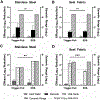Evaluation of surface disinfection methods to inactivate the beta coronavirus Murine Hepatitis Virus
- PMID: 35687041
- PMCID: PMC9547328
- DOI: 10.1080/15459624.2022.2088768
Evaluation of surface disinfection methods to inactivate the beta coronavirus Murine Hepatitis Virus
Abstract
The list of EPA-approved disinfectants for coronavirus features many products for use on hard, non-porous materials. There are significantly fewer products registered for use on porous materials. Further, many common, high-touch surfaces fall in between non-porous materials such as glass and porous materials such as soft fabrics. The objective of this study was to assess the efficacy of selected commercially available disinfectant products against coronaviruses on common, high-touch surfaces. Four disinfectants (Clorox Total 360, Bleach solution, Vital Oxide, and Peroxide Multi-Surface Cleaner) were evaluated against Murine Hepatitis Virus A59 (MHV) as a surrogate coronavirus for SARS-CoV-2. MHV in cell culture medium was inoculated onto four materials: stainless steel, latex-painted drywall tape, Styrene Butadiene rubber (rubber), and bus seat fabric. Immediately (T0) or 2-hr (T2) post-inoculation, disinfectants were applied by trigger-pull or electrostatic sprayer and either held for recommended contact times (Spray only) or immediately wiped (Spray and Wipe). Recovered infectious MHV was quantified by median tissue culture infectious dose assay. Bleach solution, Clorox Total 360, and Vital Oxide were all effective (>3-log10 reduction or complete kill of infectious virus) with both the Spray Only and Spray and Wipe methods on stainless steel, rubber, and painted drywall tape when used at recommended contact times at both T0 and T2 hr. Multi-Surface Cleaner unexpectedly showed limited efficacy against MHV on stainless steel within the recommended contact time; however, it showed increased (2.3 times greater efficacy) when used in the Spray and Wipe method compared to Spray Only. The only products to achieve a 3-log10 reduction on fabric were Vital Oxide and Clorox Total 360; however, the efficacy of Vital Oxide against MHV on fabric was reduced to below 3-log10 when applied by an electrostatic sprayer compared to a trigger-pull sprayer. This study highlights the importance of considering the material, product, and application method when developing a disinfection strategy for coronaviruses on high-touch surfaces.
Keywords: efficacy; Coronavirus; disinfection.
Conflict of interest statement
Conflict of interest statement
Neither Battelle nor the EPA manufacture or provide the products or materials described herein, nor plan to manufacture or provide these products in the future.
Figures




Similar articles
-
Efficacy of chemical disinfectants against SARS-CoV-2 on high-touch surface materials.J Appl Microbiol. 2023 Jan 23;134(1):lxac020. doi: 10.1093/jambio/lxac020. J Appl Microbiol. 2023. PMID: 36626793 Free PMC article.
-
Efficacy of detergent-based cleaning methods against coronavirus MHV-A59 on porous and non-porous surfaces.J Occup Environ Hyg. 2022 Feb;19(2):91-101. doi: 10.1080/15459624.2021.2015075. Epub 2022 Jan 28. J Occup Environ Hyg. 2022. PMID: 34878351 Free PMC article.
-
Efficacy of Disinfectants for Monkeypox Virus Inactivation on High Touch Surface Materials in Low-Resource Settings.Environ Sci Technol. 2024 Nov 12;58(45):19981-19989. doi: 10.1021/acs.est.4c09821. Epub 2024 Oct 31. Environ Sci Technol. 2024. PMID: 39481121 Free PMC article.
-
Viral Inactivation with Emphasis on SARS-CoV-2 Using Physical and Chemical Disinfectants.ScientificWorldJournal. 2021 Oct 25;2021:9342748. doi: 10.1155/2021/9342748. eCollection 2021. ScientificWorldJournal. 2021. PMID: 34712107 Free PMC article. Review.
-
Environmental disinfection against COVID-19 in different areas of health care facilities: a review.Rev Environ Health. 2020 Aug 26;36(2):193-198. doi: 10.1515/reveh-2020-0075. Print 2021 Jun 25. Rev Environ Health. 2020. PMID: 32845869 Review.
Cited by
-
Filling Critical Science Gaps: EPA Office of Research and Development's Response to COVID-19.EM Plus. 2024 3rd Quarter;2024(Q3):5-9. EM Plus. 2024. PMID: 40342573 Free PMC article.
-
Efficacy of chemical disinfectants against SARS-CoV-2 on high-touch surface materials.J Appl Microbiol. 2023 Jan 23;134(1):lxac020. doi: 10.1093/jambio/lxac020. J Appl Microbiol. 2023. PMID: 36626793 Free PMC article.
-
Efficacy of detergent-based cleaning and wiping against SARS-CoV-2 on high-touch surfaces.Lett Appl Microbiol. 2023 Mar 1;76(3):ovad033. doi: 10.1093/lambio/ovad033. Lett Appl Microbiol. 2023. PMID: 36906280 Free PMC article.
References
-
- Bolton SL, Kotwal G, Harrison MA, Law SE, Harrison JA, Cannon JL. 2013. Sanitizer efficacy against murine norovirus, a surrogate for human norovirus, on stainless steel surfaces when using three application methods. Appl Environ Microbiol. 79(4):1368–1377. doi:10.1128/AEM.02843-12 - DOI - PMC - PubMed
-
- Cadnum JL, Jencson AL, Livingston SH, Li DF, Redmond SN, Pearlmutter B, Wilson BM, Donskey CJ. 2020. Evaluation of an electrostatic spray disinfectant technology for rapid decontamination of portable equipment and large open areas in the era of SARS-CoV-2. Am J Infect Control. 48(8):951–954. doi:10.1016/j.ajic.2020.06.002 - DOI - PMC - PubMed
-
- CDC. 2020. Guidance for cleaning and disinfecting: public spaces, workplaces, businesses, schools, and homes. Atlanta (GA). September 16, 2020; [accessed 2021 Jun 11]. https://www.cdc.gov/coronavirus/2019-ncov/community/pdf/Reopening_Americ....
-
- CDC. 2021a. Cleaning and disinfecting your home. Atlanta (GA): Centers for Disease Control and Prevention; [updated 2021 Apr 5; accessed 2021 Jun 3]. https://www.cdc.gov/coronavirus/2019-ncov/prevent-getting-sick/disinfect....
Publication types
MeSH terms
Substances
Grants and funding
LinkOut - more resources
Full Text Sources
Other Literature Sources
Medical
Research Materials
Miscellaneous
